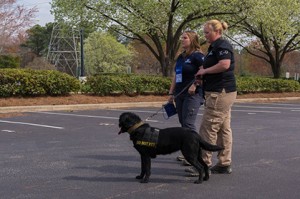American Kennel Club’s U.S. Detection Dog Conference
 The American Kennel Club (AKC®) hosted a U.S. Detection Dog Conference February 28 – March 1. The purpose of this conference was to discuss the pressing need for a U.S.-based national breeding program for explosives detection dogs. A majority of dogs procured by government agencies come from Eastern Europe, and the increasing global demand for detection dogs has made it very difficult to get quality canines. The dogs from Europe are almost impossible to get historical data on, and many times are not what they appear to be. A variety of industry leaders, including government officials, canine geneticists, and trainers, among others, came together to explain how dire the need is and discuss how to come to a solution.
The American Kennel Club (AKC®) hosted a U.S. Detection Dog Conference February 28 – March 1. The purpose of this conference was to discuss the pressing need for a U.S.-based national breeding program for explosives detection dogs. A majority of dogs procured by government agencies come from Eastern Europe, and the increasing global demand for detection dogs has made it very difficult to get quality canines. The dogs from Europe are almost impossible to get historical data on, and many times are not what they appear to be. A variety of industry leaders, including government officials, canine geneticists, and trainers, among others, came together to explain how dire the need is and discuss how to come to a solution.
Conference participants:
Sgt. Wendell Nope, K-9 Training Supervisor, Utah Department of Public Safety/U.S. Representative, International Congress of Police Service Dogs spoke about the rising threat of terrorism and the increasing need for explosives detection dogs.
Lt. Col. Matthew Enroth, DVM, Chief of Veterinary Diagnostic Imaging, U.S. Department of Defense Military Working Dogs Veterinary Services spoke about the current state of affairs in government procurement of detection dogs and the challenges he faces.
Don Roberts, Program Manager, Explosives Division, Department of Homeland Security Science & Technology Directorate gave an overview of the Department of Homeland Security Detection Dog research and development program, which aims to understand how effective these dogs are in complex search scenarios, as well as develop non-hazardous homemade explosives canine training aids in order to improve training programs.
Paul Bunker, K2 Solutions spoke about the challenges in providing dogs to clients, and gave explosives detection dogs demonstrations.
Scott Thomas, Program Manager, TSA Canine Breeding and Development Center discussed lessons learned in selective working canine breeding and the pressures involved in finding canine candidates, including sources, selection process, and the difficulty in measuring success.
Dr. Cindy Otto, Penn Vet Working Dog Center described her vision of a National Breeding Program to meet the demand of needing quality working dogs. Her vision includes a national semen bank, a breeding cooperative, a puppy raising program, a standardized screening/data collection plan and a cooperative work placement program.
Dr. Liz Hare, Statistical Geneticist, Penn Vet Working Dog Center/Dog Genetics LLS and Dr. Eldin Leighton, Canine Geneticist, Canine Genetic Services LLC discussed a plan for producing a large number of healthy, high-quality puppies purpose-bred for scent detection work.
Paul Mundell, CEO, Canine Companions for Independence and Assistance Dogs International North America (ADINA) President presented a model of a breeding coop, using the example of the ADINA Breeding Cooperative, which was established in 2013 to address problems encountered by small breeding programs.
Short URL: https://caninechronicle.com/?p=121164
Comments are closed











